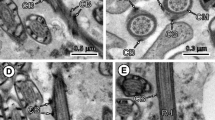Summary
Spermatogenesis of H. nodulosa from Catostomus commersoni (Catostomidae) from New York (USA) was studied by means of sections and squashes and found to consist of the following stages. Primary spermatogonia undergo a series of mitotic divisions resulting in successive linked clusters of two secondary, four tertiary, and eight quaternary spermatogonia. With succeeding divisions, sixteen primary spermatocytes are formed that have their nuclei arranged toward the periphery of a central syncytial mass. Thirty-two secondary spermatocytes arise from the first maturation division. A second maturation division yields sixty-four spherical spermatids that, still connected to the central cytoplasmic mass, subsequently mature to form spermatozoa. Thus this sequence is essentially similar to that reported for Cyclophyllidea and Pseudophyllidea. Drawings and photographs of many of the above mentioned stages supplement the description.
Similar content being viewed by others
References
Baer, J. G.: Ecology of animal parasites. Urbana: University of Illinois Press 1952.
Braun, M.: Cestodes. In: Bronn's Klassen und Ordnungen des Thier-reichs. Vermes. 4 (Abtheilung I. b.), S. 927–1731. Leipzig: C. F. Winter'sche Verlagshandlung 1894–1900.
Burton, P. R.: Gametogenesis and fertilization in the frog lung fluke, Haematoloechus medioplexus Stafford (Trematoda: Plagiorchiidae). J. Morph. 107, 93–122 (1960).
Child, C.: Studies on the relation between amitosis and mitosis. II. Development of the testes and spermatogenesis in Moniezia. Biol. Bull. 12, 175–224 (1907).
Douglas, L. T.: The development of organ systems in nematotaeniid cestodes. III. Gametogenesis and embryonic development in Barietta diana and Distoichometra kosloffi. J. Parasit. 49, 530–558 (1963).
Hannah-Alava, A.: The premeiotic stages of spermatogenesis. In: W. E. Caspari, J. M. Thoday, eds., Advanc. Genet. 13, 157–226 (1965).
Jones, A. W., Mackiewicz, J. S.: Naturally occurring triploidy and parthenogenesis in Atractolytocestus huronensis Anthony (Cestoidea: Caryophyllidea) from Cyprinus carpio L. in North America. J. Parasit. 55, 1105–1118 (1969).
— Mayer, T. C.: The chromosomes of Spirorchis magnitestis Byrd (Trematoda, Digenea). J. Tenn. Acad. Sci. 28, 301–304 (1953).
Kanwar, U., Anand, R.: Sperm cytoplasmic remnants in the nematode Ascaridia galli. J. Parasit. 57, 193 (1971).
Llewellyn, J.: The evolution of parasitic platyhelminthes. In: Evolution of parasites. Third Symposium of the British Society for Parasitology, p. 47–78. Oxford: Blackwell Scientific Publications 1965.
Mackiewicz, J. S., Jones, A. W.: The chromosomes of Hunterella nodulosa Mackiewicz and McCrae, 1962 (Cestoidea: Caryophyllidea). Proc. Helminth. Soc. Wash. 36, 126–131 (1969).
— McCrae, R.: Hunterella nodulosa gen. n., sp. n. (Cestoidea: Caryophyllaeidae) from Catostomus commersoni (Lacépède) (Pisces: Catostomidae) in North America. J. Parasit. 48, 798–806 (1962).
Paschchenko, L. F.: Rannije stadii spermatogeneza u Taeniarhynchus saginatus Goeze, 1782. Problemy Parazitologii, Trudy Ukrainskogo Nauchnogo Obshchestua Parazitologow, Kiev 1, 112–122 (1961).
Rybicka, K.: Observations sur la spermatogenèse d'un cestode pseudophyllidean Triaenophorus lucii (Müll., 1776). Bull. Soc. Neuchâtel Sci. Nat. 85, 177–181 (1962a).
— La spermatogenèse du cestode Dipylidium caninum (L.). Bull. Soc. Zool. Fr. 87, 225–228 (1962b).
— Gametogenesis and embryonic development in Dipylidium caninum. Exp. Parasit. 15, 293–313 (1964).
Rybicka, K.: Embryogenesis in cestodes. In: B. Dawes ed., Advances in parasitology, vol. 4, p. 107–178. New York: Academic Press Inc. 1966.
Stunkard, H. W.: The organization, ontogeny, and orientation of the cestoda. Quart. Rev. Biol. 37, 23–34 (1962).
Will, H.: Anatomie von Caryophyllaeus mutabilis Rd. Z. wiss. Zool. 56, 1–39 (1893).
Yosufzai, H.: Cytological studies on the spermatogenesis of Fasciola hepatica L. Cellule 55, 7–19 (1952).
Young, R. T.: The histogenesis of the reproductive organs of Taenia pisiformis. Zool. Jb., Abt. Anat. d. Ontog. 35, 355–418 (1913).
— Gametogenesis in cestodes. Arch. Zellforsch. 17, 419–437 (1923).
Wisniewski, L. W.: Das genus Archigetes R. Leuck. Eine Studie zur Anatomie, Histogenese, Systematik und Biologie. Mem. Acad. Polanaise Sci. et Lettres, Cl. Sci. Math. Nat., Ser. B 2, 1–168 (1930).
Author information
Authors and Affiliations
Additional information
From whom reprints should be requested.
Rights and permissions
About this article
Cite this article
Kazacos, K., Mackiewicz, J.S. Spermatogenesis in Hunterella nodulosa Mackiewicz and McCrae, 1962 (Cestoidea: Caryophyllidea). Z. F. Parasitenkunde 38, 21–31 (1971). https://doi.org/10.1007/BF00259481
Received:
Issue Date:
DOI: https://doi.org/10.1007/BF00259481




